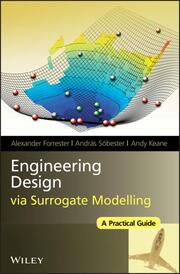Detailansicht
Engineering Design via Surrogate Modelling
A Practical Guide
ISBN/EAN: 9780470060681
Umbreit-Nr.: 1845015
Sprache:
Englisch
Umfang: 256 S.
Format in cm:
Einband:
gebundenes Buch
Erschienen am 25.07.2008
Auflage: 1/2008
- Zusatztext
- InhaltsangabePreface. About the Authors. Foreword. Prologue. Part I: Fundamentals. 1. Sampling Plans. 1.1 The 'Curse of Dimensionality' and How to Avoid It. 1.2 Physical versus Computational Experiments. 1.3 Designing Preliminary Experiments. 1.3.1 Estimating the Distribution of Elementary Effects. 1.4 Designing a Sampling Plan. 1.4.1 Stratification. 1.4.2 Latin Squares and Random Latin Hypercubes. 1.4.3 Spacefilling Latin Hypercubes. 1.4.4 Spacefilling Subsets. 1.5 A Note on Harmonic Responses. 1.6 Some Pointers for Further Reading. References. 2. Constructing a Surrogate. 2.1 The Modelling Process. 2.1.1 Stage One: Preparing the Data and Choosing a Modelling Approach. 2.1.2 Stage Two: Parameter Estimation and Training. 2.1.3 Stage Three: Model Testing. 2.2 Polynomial Models. 2.2.1 Example One: Aerofoil Drag. 2.2.2 Example Two: a Multimodal Testcase. 2.2.3 What About the k-variable Case? 2.3 Radial Basis Function Models. 2.3.1 Fitting Noise-Free Data. 2.3.2 Radial Basis Function Models of Noisy Data. 2.4 Kriging. 2.4.1 Building the Kriging Model. 2.4.2 Kriging Prediction. 2.5 Support Vector Regression. 2.5.1 The Support Vector Predictor. 2.5.2 The Kernel Trick. 2.5.3 Finding the Support Vectors. 2.5.4 Finding µ. 2.5.5 Choosing C and µ. 2.5.6 Computing µ: v-SVR 71. 2.6 The Big(ger) Picture. References. 3. Exploring and Exploiting a Surrogate. 3.1 Searching the Surrogate. 3.2 Infill Criteria. 3.2.1 Prediction Based Exploitation. 3.2.2 Error Based Exploration. 3.2.3 Balanced Exploitation and Exploration. 3.2.4 Conditional Likelihood Approaches. 3.2.5 Other Methods. 3.3 Managing a Surrogate Based Optimization Process. 3.3.1 Which Surrogate for What Use? 3.3.2 How Many Sample Plan and Infill Points? 3.3.3 Convergence Criteria. 3.3.4 Search of the Vibration Isolator Geometry Feasibility Using Kriging Goal Seeking. References. Part II: Advanced Concepts. 4. Visualization. 4.1 Matrices of Contour Plots. 4.2 Nested Dimensions. Reference. 5. Constraints. 5.1 Satisfaction of Constraints by Construction. 5.2 Penalty Functions. 5.3 Example Constrained Problem. 5.3.1 Using a Kriging Model of the Constraint Function. 5.3.2 Using a Kriging Model of the Objective Function. 5.4 Expected Improvement Based Approaches. 5.4.1 Expected Improvement With Simple Penalty Function. 5.4.2 Constrained Expected Improvement. 5.5 Missing Data. 5.5.1 Imputing Data for Infeasible Designs. 5.6 Design of a Helical Compression Spring Using Constrained Expected Improvement. 5.7 Summary. References. 6. Infill Criteria With Noisy Data. 6.1 Regressing Kriging. 6.2 Searching the Regression Model. 6.2.1 ReInterpolation. 6.2.2 ReInterpolation With Conditional Likelihood Approaches. 6.3 A Note on Matrix Ill-Conditioning. 6.4 Summary. References. 7. Exploiting Gradient Information. 7.1 Obtaining Gradients. 7.1.1 Finite Differencing. 7.1.2 Complex Step Approximation. 7.1.3 Adjoint Methods and Algorithmic Differentiation. 7.2 Gradientenhanced Modelling. 7.3 Hessianenhanced Modelling. 7.4 Summary. References. 8. Multifidelity Analysis. 8.1 CoKriging. 8.2 Onevariable demonstration. 8.3 Choosing Xc and Xe. 8.4 Summary. References. 9. Multiple Design Objectives. 9.1 Pareto Optimization. 9.2 Multiobjective Expected Improvement. 9.3 Design of the Nowacki Cantilever Beam Using Multiobjective, Constrained Expected Improvement. 9.4 Design of a Helical Compression Spring Using Multiobjective, Constrained Expected Improvement. 9.5 Summary. References. Appendix: Example Problems. A.1 OneVariable Test Function. A.2 Branin Test Function. A.3 Aerofoil Design. A.4 The Nowacki Beam. A.5 Multiobjective, Constrained Optimal Design of a Helical Compression Spring. A.6 No
- Autorenportrait
- Dr. Alexander I. J. Forrester is Lecturer in Engineering Design at the University of Southampton. His main area of research focuses on improving the efficiency with which expensive analysis (particularly computational fluid dynamics) is used in design. His techniques have been applied to wing aerodynamics, satellite structures, sports equipment design and Formula One. Dr Andras Sobester is a Lecturer and EPSRC/ Royal Academy of Engineering research Fellow in the School of Engineering Sciences at the University of Southampton. His research interests include aircraft design, aerodynamic shape parameterization and optimization, as well as engineering design technology in general. Professor Andy J. Keane currently holds the Chair of Computational Engineering at the University of Southampton. He leads the University's Computational Engineering at the Design Research Group and directs the rolls-Royce University Technology centre for Computational Engineering. His interests lie primarily in the aerospace sciences, with a focus on the design of aerospace systems using computational methods. He has published over two hundred papers and three books in this area, many of which deal with surrogate modelling concepts.
